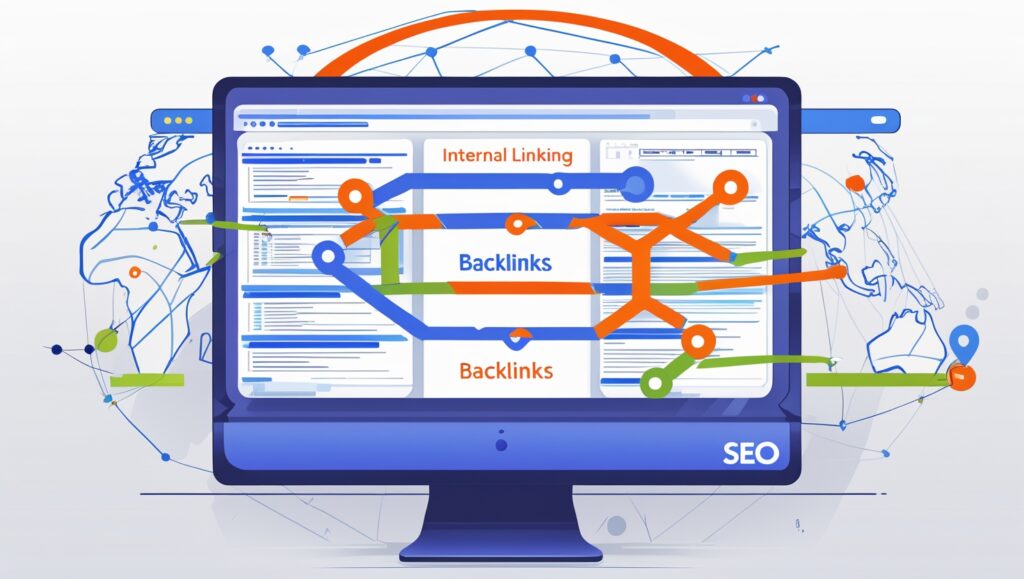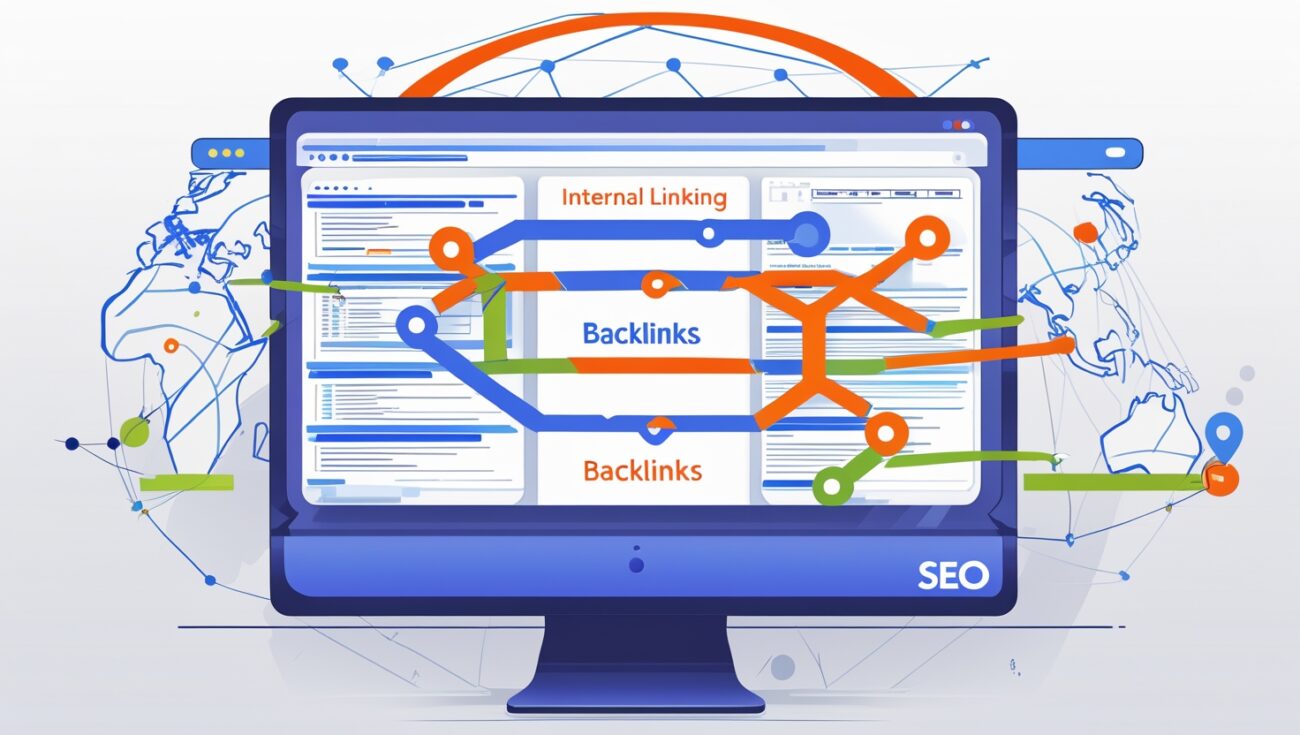Internal Linking vs Backlinks: Understanding the Difference
When it comes to Search Engine Optimization (SEO), you’ll often hear about the importance of both internal linking and backlinks. While both are crucial for improving your website’s visibility in search results, they serve different purposes and function in distinct ways.
Understanding the difference between internal linking and backlinks is fundamental for developing a successful SEO strategy. Let’s dive into what each entails and why they both matter.

Table of Contents
What is Internal Linking?
As we discussed in our previous post, internal links are hyperlinks that connect one page of your website to another page on the same website. They act as pathways within your own domain, helping users and search engine crawlers navigate your content. Think of them as the internal roadmap of your site. By strategically placing internal links, you guide visitors to related articles, product pages, or any other relevant content within your website. This improves user experience by making it easier for them to find the information they need and encourages them to explore more of your site.
What are Backlinks?
Backlinks, on the other hand, are links from other websites to your website. They are essentially votes of confidence from external sources, signaling to search engines that other websites find your content valuable and trustworthy. The more high-quality backlinks you have from reputable websites, the more authority and credibility your site gains in the eyes of search engines like Google. These external links are a significant ranking factor, indicating that your content is worth referencing and sharing.
Key Differences Between Internal Linking and Backlinks
The primary difference lies in the source and destination of the link. Internal links connect pages within the same domain, while backlinks originate from an external domain and point to your website. Here’s a table summarizing some key distinctions:
| Feature | Internal Linking | Backlinks |
| Origin | Within the same website | From external websites |
| Destination | Another page on the same website | Your website |
| Control | You have full control | Limited or no direct control |
| Purpose | Navigation, user experience, content hierarchy | Authority building, credibility, referral traffic |
Export to Sheets
Why Internal Linking Matters for SEO
Effective internal linking offers several significant benefits for SEO:
- Improved Website Navigation: It helps users easily find related content, leading to a better user experience and longer time on site.
- Enhanced Crawlability: Search engine bots use internal links to discover and index all the pages on your website. A well-structured internal link network ensures that all your important content is accessible to these crawlers.
- Distribution of Link Equity: Internal links help distribute “link equity” (or ranking power) throughout your site. Linking from high-authority pages to less authoritative ones can help boost their visibility.
- Increased Page Views: By guiding users to related content, internal links encourage them to visit more pages on your site, reducing bounce rate.
- Contextual Understanding: Strategic internal links can help search engines understand the relationships between different pieces of content on your website and the overall topic authority of your site.
Why Backlinks Matter for SEO
Backlinks are a critical ranking factor for several reasons:
- Authority and Trustworthiness: High-quality backlinks from reputable websites act as endorsements, signaling to search engines that your content is trustworthy and authoritative.
- Improved Search Engine Rankings: Websites with a strong backlink profile tend to rank higher in search results for relevant keywords.
- Referral Traffic: Backlinks can drive valuable referral traffic to your website from users who click on the links on other sites.
- Discovery by Search Engines: Just as internal links help search engines discover content within your site, backlinks help them discover your site from other places on the web.
Can You Have One Without the Other?
While it’s technically possible to have a website with many internal links but few backlinks, or vice versa, a balanced approach is essential for optimal SEO performance.
- A website with strong internal linking but weak backlinks might be easy to navigate for users and crawl for search engines, but it may lack the authority needed to rank highly in competitive search results.
- Conversely, a website with many backlinks but poor internal linking might have authority but could suffer from high bounce rates and poor user experience due to a lack of clear navigation.
The Synergistic Relationship
The most effective SEO strategies leverage both internal linking and backlinks in a complementary way. Strong internal linking ensures that the authority gained from backlinks is distributed effectively throughout your site, boosting the ranking potential of all your important pages. Furthermore, valuable content that is well-organized through internal linking is more likely to attract backlinks from other websites.
Building Your Link Strategy
Developing a robust link strategy involves:
- Strategic Internal Linking: Identifying opportunities to link relevant pages within your website using descriptive anchor text. Consider using tools like Linkbot (click here to explore its features and see how it can help: https://linkbot.com?fpr=audrey95) to manage and optimize your internal links efficiently.
- Earning High-Quality Backlinks: Creating valuable, shareable content that naturally attracts backlinks from other reputable websites. This can involve guest blogging, outreach, and creating compelling resources.
Conclusion
Understanding the difference between internal linking and backlinks is crucial for anyone looking to improve their website’s SEO. While internal links focus on the structure and user experience within your own domain, backlinks build your website’s authority and credibility in the broader web ecosystem. By strategically implementing both, you can create a website that is not only easy for users to navigate but also highly regarded by search engines, ultimately leading to improved visibility and organic traffic. Make sure to prioritize both aspects in your ongoing SEO efforts.
Anchor text is a crucial element for both internal linking and backlinks, but its function is slightly different for each. For internal links, using descriptive anchor text helps guide users and search engines to the exact content they need, improving relevance and user experience. With backlinks, the anchor text provides a powerful signal to Google about what the destination page is about, which can significantly influence its rankings for those specific keywords.
The process of acquiring backlinks is fundamentally different from building internal links. Internal links are completely within your control; you can add, edit, or remove them as you see fit. You have the power to create a structured and intentional web of content. In contrast, backlinks must be earned. They are the result of creating high-quality, valuable content that other website owners genuinely want to reference and link to. This is why content marketing is so vital for off-page SEO.
The long-term value of a link can also vary. A strategically placed internal link will provide value for as long as that page exists, helping to distribute link equity consistently. However, a single high-quality backlink from a very authoritative website can provide an enormous and lasting boost to your site’s credibility, potentially improving the rankings of many pages on your site, not just the linked one.
One thing I’ve learned is that it’s important to have a diverse link profile, which includes both do-follow and no-follow links. While only do-follow links pass on “link juice,” a mix of both types looks more natural to Google’s algorithms. A website with only do-follow links could signal an unnatural, manipulative link-building strategy. A healthy backlink profile is a mix of different link types and sources.
Auditing your link profile is essential for both types of links. With internal links, you need to regularly check for broken links and update outdated ones to maintain a clean and efficient site structure. For backlinks, you must monitor for toxic or spammy links pointing to your site, as these can harm your rankings. Identifying and disavowing harmful links is a critical part of maintaining your site’s health.
The overall “link profile” of your website encompasses both your internal linking structure and your backlinks. A strong profile is a sign of a healthy, well-managed website. It tells Google that you are a reliable source of information, both because your content is well-organized internally and because it is trusted by external sources. A balanced and clean link profile is a powerful SEO asset.
Toxic links, also known as spammy links, are something I’ve had to deal with myself. These are backlinks from low-quality, irrelevant, or even malicious websites. Google’s Penguin algorithm was designed to penalize sites with a high number of these toxic links. This is why a proactive backlink audit is so important—it’s not just about building links, it’s about protecting your site from harmful ones.
The relationship between internal linking and your site’s information architecture is inseparable. A strong internal link structure is the foundation of a logical and intuitive website. It organizes your content into a clear hierarchy, helping both users and search engines understand the most important pages and how all your content relates to one another.
The quality of your content directly impacts both types of links. High-quality, valuable content naturally attracts high-quality backlinks from other sites. At the same time, great content gives you more opportunities to add relevant internal links to other pieces on your site, keeping visitors engaged and improving their experience. You can’t have a strong link strategy without a strong content strategy.
Both internal linking and backlinks contribute to your site’s overall “authority.” Backlinks are the primary driver of this authority from an external standpoint, acting as external votes. Internal links, on the other hand, help distribute that earned authority to the rest of your site. It’s a powerful combination: you earn the authority from external sources and then spread it throughout your entire domain using internal links.
With the rise of mobile-first indexing, the importance of a clean and efficient link structure has become even more critical. Google’s mobile crawler prioritizes a mobile-friendly site, and a well-thought-out internal linking strategy ensures that all your content is easily accessible and crawlable on any device. Bad internal linking can be just as detrimental on a mobile site as it is on a desktop one.
Managing your link strategy, both internal and external, can feel overwhelming. That’s where tools come in. I’ve found that using a dedicated link management tool can make a world of difference. It helps you find broken links, identify linking opportunities, and keep track of your overall link profile, so you can focus on creating great content. Click here to learn more about how a tool like Linkbot can help streamline your link management.

